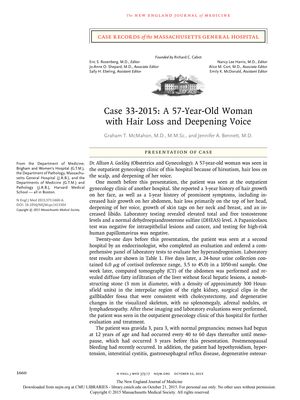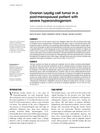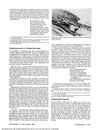Case 33-2015
October 2015
in “
The New England Journal of Medicine
”
hyperandrogenism hirsutism scalp hair loss ovarian hyperthecosis testosterone transvaginal ultrasonography endometrial biopsy robot-assisted laparoscopic total hysterectomy bilateral salpingo-oophorectomy alopecia dermatologist postmenopausal hyperandrogenism hair loss hair growth hysterectomy ovary removal

TLDR The woman's surgery lowered her testosterone and improved scalp hair loss but did not change her excessive body hair.
The document detailed the case of a 57-year-old woman with symptoms of hyperandrogenism, including hirsutism, scalp hair loss, and a deepening voice, leading to a diagnosis of ovarian hyperthecosis. Elevated testosterone levels were noted, but imaging showed no tumors. Transvaginal ultrasonography and an endometrial biopsy supported the diagnosis, which was confirmed after a robot-assisted laparoscopic total hysterectomy and bilateral salpingo-oophorectomy. Post-surgery, the patient's testosterone levels decreased, and her alopecia mildly improved, but her hirsutism did not change. She was referred to a dermatologist for further symptom management. The document highlights that hirsutism typically does not revert after treatment for postmenopausal hyperandrogenism, but scalp hair growth usually recovers, and a more feminine body habitus is restored.






